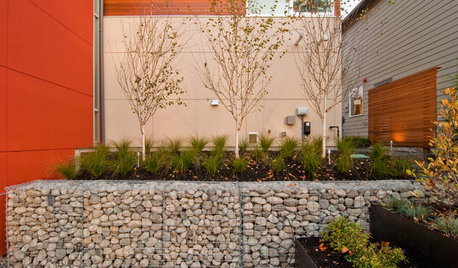Root permeability
gotoguy
18 years ago
Related Stories

LANDSCAPE DESIGNSoak It Up: How to Manage Stormwater in Your Landscape
Permeable paving, gravel beds and planted areas in your yard can absorb and cleanse stormwater runoff. Here's how it works
Full Story
LANDSCAPE DESIGN5 Gravel and Stone Types for a Rockin' Landscape
Give your garden design some textural bam with pebbles, granite, river rocks and other permeable materials
Full Story
GARDENING AND LANDSCAPINGPatio Pavers Go Green in Between
Kind to the environment and easy on the eyes, pavers with moss or other foliage in the joints create a charming permeable hardscape
Full Story
LANDSCAPE DESIGNGarden Walls: Gabion Evolves From Functional to Fabulous
The permeable rock-, concrete- or glass-filled steel cages are showing up as retaining walls, planters, benches and more
Full Story
LANDSCAPE DESIGNLandscaping Tricks to Manage Stormwater Runoff
Help rainwater absorb slowly back into the earth with paving grids, gravel beds and other porous systems
Full Story
LANDSCAPE DESIGNEvoke Mystery and History With Moss in the Garden
Go ahead, lie about age. Moss on garden statues, planters and pavers creates the beautifully deceptive look of time’s passing
Full Story
ARCHITECTUREDesign Workshop: Give Me an ‘H’
Look to modern versions of an H-shaped medieval floor plan for more privacy and natural light
Full Story
GARDENING AND LANDSCAPINGPostage Stamp Garden Delivers in Boston
A designer conquers an urban challenge with a private, green, modern space that honors New England tradition
Full Story
LANDSCAPE DESIGN17th-Century Ideas Add Formal Grandeur to the Garden
Landscapes of all sizes can learn a thing or two from the grand gardens of the past
Full Story
ARCHITECTUREDesign Workshop: The Modern Dogtrot
Some surprising facts and new twists on this utilitarian favorite
Full Story






nazanine
gotoguyOriginal Author
Related Professionals
Forest City Landscape Architects & Landscape Designers · Apollo Beach Landscape Contractors · Belmont Landscape Contractors · Cedar Hill Landscape Contractors · Desert Hot Springs Landscape Contractors · Dudley Landscape Contractors · Kaneohe Landscape Contractors · Kettering Landscape Contractors · Lakewood Landscape Contractors · Santa Ana Landscape Contractors · Webster Groves Landscape Contractors · Whittier Landscape Contractors · Issaquah Fence Contractors · Minneapolis Fence Contractors · Yorba Linda Fence Contractorstaxonomist
nazanine
pinetree30
gotoguyOriginal Author
wild_rose